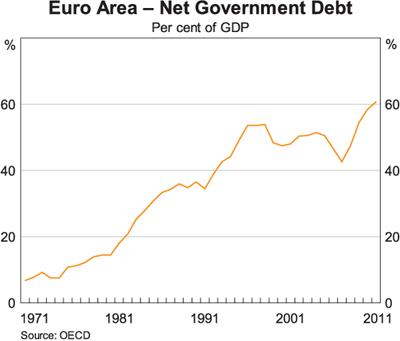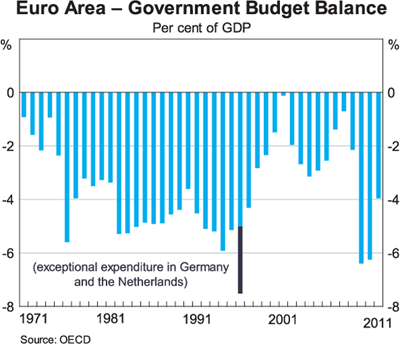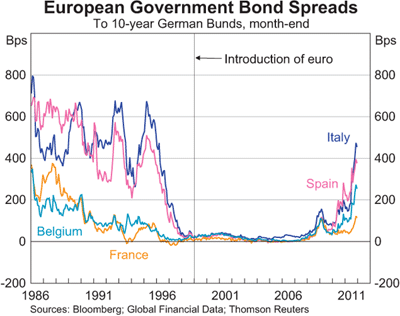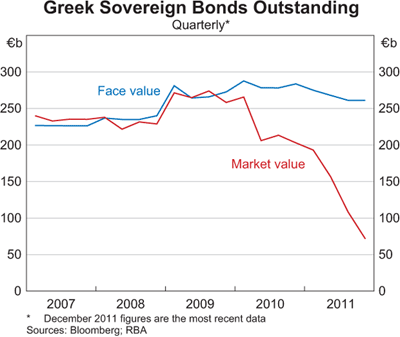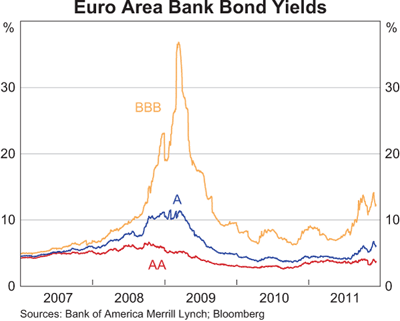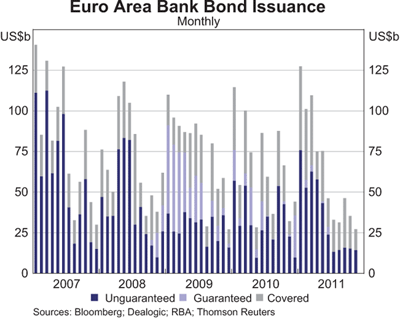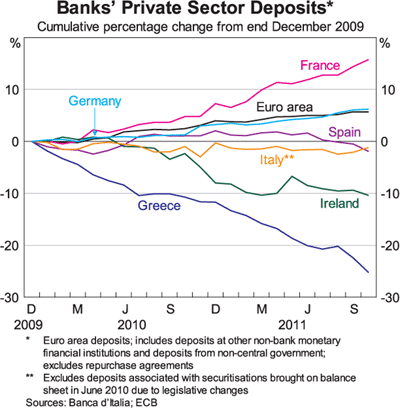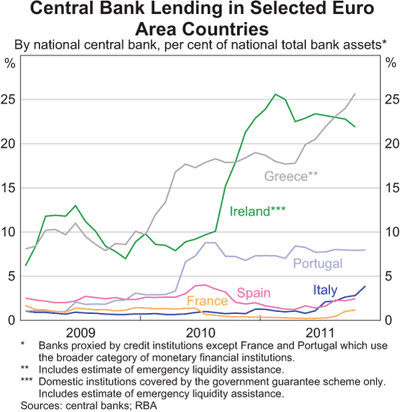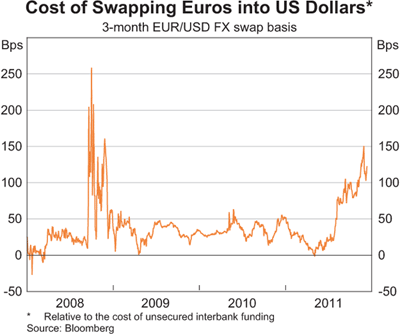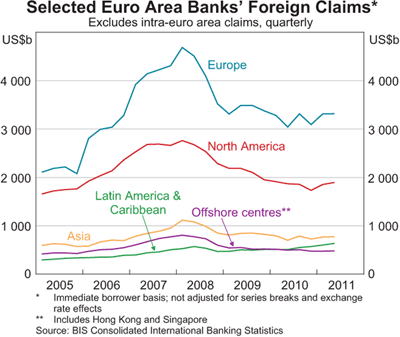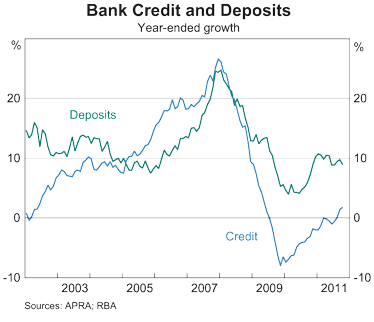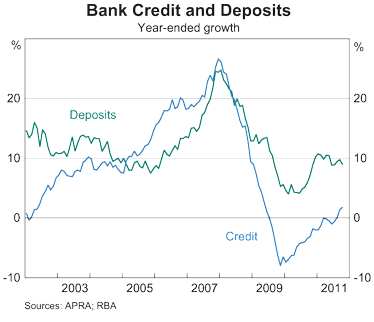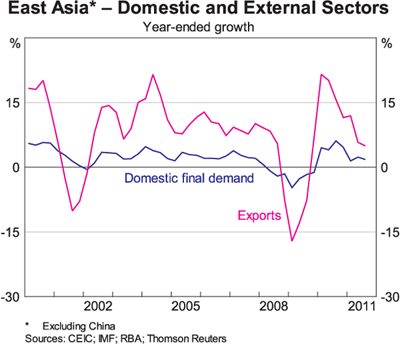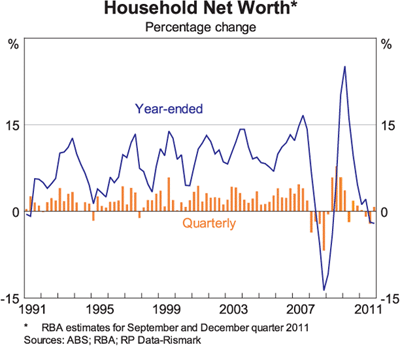This piece is in favor of Australia (of course) but the Eurozone is in for a string of shit.
From Reserve Bank of Australia:
Introduction
From Reserve Bank of Australia:
Introduction
Over recent months we have all watched with concern the
growing financial problems in Europe.
The problems are multi-dimensional,
involving excessive government debt, weak banking sectors,
slowing economic growth and marked
differences in competitiveness across countries within the euro area.
They have become the main threat
facing the global economy
and the international financial
system.
It is hard to tell how and when the problems will be
resolved. In the meantime, turbulence continues
in global financial markets and
most forecasters are now predicting a very significant weakening in the
European economy over the coming
year as government spending is cut back, credit
tightens and confidence declines.
Given the size of the European economy and financial system,
it will be hard to avoid adverse
consequences for other parts of the world, though the extent of
these spillovers remains an open
question. At this stage, most forecasters think that growth in
the world economy will be only a
little below trend in the coming year,
though with the risk of a
significantly worse outcome.
Australia, like other countries,
will be affected by the events in Europe, but its strong government
finances, healthy banking sector
and relatively limited direct trade and financial exposures to
Europe make it one of the countries
best placed to weather the situation. Australia is also fortunate
to be subject, simultaneously, to a
resources boom that is resulting in unprecedented investment
and therefore helping to sustain
economic activity.
I will begin my talk today with a
round-up of the European government debt situation. I will be brief as
I think we all know the broad facts. I will then focus on the effect
that the deterioration in government debt has had on European banks and
the role that European banks are playing in spreading the problem to
other countries. I will conclude by looking at the channels through
which Australia could be affected, including through financial links,
trade links and effects on confidence and wealth.
The European Debt Situation
As you know, the trigger for the problems currently being
experienced in Europe was the rapid build up in government debt
following the global financial crisis. Government budgets deteriorated
sharply after 2008, due to the weakening in economic activity, the large
fiscal stimulus applied by governments and, in some cases, the cost of
bailing out banks.
Government debt in the euro area had been rising as a ratio to GDP,
however, for much of the period since the 1970s (Graph 1). This occurred
because governments loosened fiscal policy during recessions but did
not fully reverse those policies during the subsequent cyclical
recoveries. In aggregate, budgets in the countries that now form the
euro area have been continuously in deficit for the past 40 years (Graph
2). Clearly, there was no fiscal rule that aimed to balance the budget
over the economic cycle, as there is in Australia.
Graph 1
Graph 2
At the onset of the global financial crisis, the
ratio of net government debt to GDP in the euro area was about 45 per
cent and it has since risen to around 60 per cent. Within the euro area,
Greece has the highest net debt ratio, at about 130 per cent, with
Italy next, at about 100 per cent.
Concerns in financial markets about the
sustainability of government debt levels in Europe first emerged in late
2009, when the Greek Government revealed that its fiscal position was
significantly worse than it had previously led the markets to believe.
Greek sovereign debt was downgraded and spreads on the debt widened,
despite some fiscal tightening. By April 2010, the situation in Greece
had deteriorated to the point where it was forced to seek external
financial assistance from the IMF and other European countries.
As typically happens, market participants quickly
began to ask which country might be next, and spreads in some other
euro-area countries also began to widen sharply. By November 2010,
Ireland had been forced to ask for external assistance, and Portugal
followed in April 2011. Recently, Italy and Spain have also come under
severe financial pressure, though as yet have not needed external
assistance.
As the crisis has spread, a succession of
measures has been announced to try to contain the problem, the latest
being announced last weekend. These have typically provided some
short-term respite, but in the past none has managed to provide lasting
reassurance to financial markets. It remains to be seen whether the
latest measures will be more successful. Most commentators see the
long-term solution as involving greater fiscal co-ordination and
discipline. In the short term, it is highly likely that part of the
solution will involve substantial financial assistance from outside the
region or the purchase of sovereign debt by the ECB, or some combination
of both.
A sticking point here is that the ECB's charter
precludes it from providing direct financing to governments. The ECB was
initially also reluctant to buy government debt in the secondary
market, though it has done so in substantial quantities recently. The
restriction on the ECB's funding of governments was put in place both to
guard against the risk of inflation and to avoid the moral hazard that
would arise if national governments had direct access to central bank
financing in a situation where there is no central co-ordination of
fiscal policy.
While an arrangement where the central bank is
precluded from direct financing of the government guards against the
risk of inflation – i.e. monetary instability – it increases the risk of
financial instability. This is because if the central bank is not
prepared to step in as a financial back-stop, a government that is
unable to fund itself in the market is left with no option but to
default or seek external assistance. It is highly unusual for a
government in a developed economy to be forced to seek funding from an
external party such as the IMF.
The concerns about the sustainability of debt levels
in various countries have resulted in interest rates on government debt
rising sharply in some countries, returning to the relativities that
prevailed before the formation of the euro (Graph 3). Pre-euro, there
was a wide variation in the interest rates paid by European governments,
reflecting each country's history of inflation and fiscal discipline.
The formation of the euro area brought convergence of interest rates
towards the low levels previously enjoyed only by Germany, but pre-euro
relativities are now re-asserting themselves. This suggests that markets
are pricing in the possibility of a break-up of the euro area or a
significant risk of default by some governments, or both.
Graph 3
The Effect on European Banks
The problems in European sovereign debt markets have affected European banks through two main channels:
- first, these banks have experienced valuation losses on their sovereign debt holdings; and
- second, these losses have raised concerns about the financial soundness of banks, particularly in an environment where some governments are seen as having less capacity to support banks financially. This has caused investors and other banks to become reluctant to lend to them, and has pushed up banks' funding costs.
Let me say something about each of these points in turn.
Euro-area banks, in total, hold about €2.5 trillion of euro-area
sovereign debt.
This is about one-third of all the euro-area sovereign debt on
issue. The exposure is quite substantial, being equal to about 8 per
cent of these banks' assets and 130 per cent of their Tier 1 capital.
The majority of the debt held by banks in each country is home-country
debt but, not surprisingly for a common-currency area, there are also
large cross-border holdings. This is particularly the case for Italian
debt, which is widely held by non-Italian banks.
Given the rise in yields that has occurred in some countries, the
market value of the bonds has declined significantly. Greek debt, for
example, has fallen in value by around 70 per cent. This means that even
though the face value of Greek debt is about €260 billion, the market
value of the debt is now only about €75 billion (Graph 4). Italian debt
has fallen in value by 10 per cent. Banks have brought some of these
losses to account already, but they remain heavily exposed to further
losses if the situation continues to deteriorate.
Graph 4
As I mentioned, concerns about these exposures have made investors
and depositors more cautious. The cost of long-term funds has risen
sharply (though it remains below that reached during the global
financial crisis) and, for some euro-area banks, bond markets have
largely closed. As such, very few bonds have been issued by euro-area
banks recently (Graphs 5 and 6).
Graph 5
Graph 6
Banks in some euro-area countries have also suffered large reductions
in deposits. Greek bank deposits have fallen by about 25 per cent over
the past couple of years and deposits in Irish banks by 10 per cent.
Italian and Spanish banks have experienced a small fall in deposits.
Banks in Germany and France, in contrast, have experienced increases (Graph 7).
Graph 7
With banks under funding pressure, the ECB has had to increase its
lending to banks. Essentially, it currently allows euro-area banks to
borrow as much as they need (subject to the availability of eligible
collateral) at its policy interest rate, for periods up to three years.
Some banks have increased their use of ECB funding significantly: Greek
banks and Irish banks are financing almost one-quarter of their balance
sheets from either the ECB or their national central bank (Graph 8).
For the banking system as a whole, however, central bank funding is
equivalent to less than 3 per cent of liabilities.
Graph 8
European banks have also found it increasingly difficult to access US
dollar funds, which they use to fund US dollar assets, including trade
finance. Lending to euro-area banks by US money market funds has fallen
by 55 per cent this past year. In response, banks have turned to foreign
exchange swap markets to source US dollars, pushing up the cost
significantly (Graph 9).
Graph 9
To alleviate the shortage of US dollar funds among European banks,
the US Federal Reserve has re‑activated its US dollar swap lines with a
number of other central banks. This is to allow these central banks to
lend US dollars to banks in their jurisdiction. Until recently, however,
banks had not made much use of this facility, instead seeking to reduce
their need for US dollars by selling US dollar assets and cutting back
on cross-border financing. Following the recent reduction in the
interest charged on the facility, however, usage has picked up somewhat.
To try to enhance investor confidence, European banking authorities
recently announced a requirement for a large number of euro-area banks
to lift their core Tier 1 capital ratios to 9 per cent by mid 2012.[2]
It has been estimated that, other things equal, this would require
about €115 billion of new capital. This is not a particularly large
amount, being equivalent to about 12 per cent of these banks' current
capital. Nonetheless, there is evidence that at least some banks are
unwilling or unable to raise equity and are seeking to achieve the
higher capital ratio by reducing assets, particularly in offshore
markets. This will add to the general tightening of global credit
conditions.
Euro-area banks are large participants in cross-border lending, though
this is mainly oriented towards other European countries and North
America (Graph 10). Their role in the Asian region is smaller, though
they are thought to play a significant role in trade financing. While no
data are available for the recent months during which the European
banking problems have escalated, anecdotal evidence suggests that a lack
of trade financing is not as significant a problem in Asia as it was in
2008.
Graph 10
Australia's Exposure to European Developments
There are various channels through which developments in Europe could
affect Australia. These include financial linkages, trade linkages and
confidence and wealth effects.
(a) Financial linkages
The direct exposures of Australian banks to the euro area are small.
Their claims on euro-area countries amount to $87 billion, or 2.7 per
cent of total assets. Moreover, 80 per cent of this exposure is to
Germany, France and the Netherlands (Table 1).
| Banks | Public sector | Private sector | Total | ||
|---|---|---|---|---|---|
| $billion | $billion | $billion | $billion | Per cent of assets | |
(a) Australian-owned banks and subsidiaries and branches of foreign-owned banks; exposures include those to foreign-owned banks booked in Australia. Source: APRA |
|||||
| Euro area | 66.2 | 4.1 | 16.9 | 87.2 | 2.7 |
| of which: | |||||
| Greece, Ireland, Italy, Portugal and Spain | 2.2 | 0.7 | 3.3 | 6.1 | 0.2 |
| France, Germany and the Netherlands | 59.2 | 3.0 | 12.4 | 74.6 | 2.3 |
The main effect of the European crisis on Australian banks is through
the increased cost of funds in global markets as debt has become more
expensive in Australian banks sharply have reduced their issues of
long-term debt (Graph 11). Short-term debt remains more readily
available, particularly in the United States, where money market funds
have shifted their investments from European banks to Australian,
Canadian and Japanese banks.
Graph 11
Australian banks, overall, remain
relatively liquid as they continue to receive strong inflows of
deposits. Over the past year, total bank deposits in Australia have
risen by 9 per cent, which has been more than sufficient to fund the
increase in banks' lending (Graph 12).
Graph 12
(b) Trade links
The euro area accounts for only about 4 per cent of Australia's
merchandise exports, a low share compared with many other countries.
| % | ||
|---|---|---|
| *
Excluding re-exports from Hong Kong and
Singapore and oil exports from Singapore Source: ABS; CEIC; Eurostat; IMF; ONS; RBA; Thomson Reuters |
||
| United Kingdom | 49 | |
| Sweden | 39 | |
| India | 15 | |
| China | 15 | |
| United States | 14 | |
| East Asia* | 11 | |
| Japan | 8 | |
| Canada | 5 | |
| Australia | 4 | |
While the direct exposure of Australia to a slowing in European
demand is low, the indirect exposure, through the effect on some of our
important trading partners, could be significant. China and India, for
example, both ship a substantial share of their exports to the euro area
and these could be expected to decline. Further, history shows that,
when exports slow, domestic demand in Asia also slows, albeit to a
lesser degree (Graph 13).
Graph 13
Overall, it would be prudent to assume that, if the European economy
were to slow markedly over the next year or so, Australia would be
affected,
particularly through indirect trade exposures. It is also likely,
however, that if that were to eventuate, the exchange rate of the
Australian
dollar would weaken, as it has when the global economy has weakened in
the past, providing some cushion for the Australian economy.
(c) Confidence and wealth effects
Confidence and wealth effects are difficult to quantify, but ultimately can be very important in transmitting economic shocks.
Household confidence in Australia was below average through much
of 2011, with households being particularly pessimistic about their
financial situation over the coming year. No doubt, these perceptions
were being affected by the unsettling financial news coming out of
Europe and the associated large declines in share prices. In recent
months, however, measures of confidence have improved despite the
escalating problems in Europe and the continuing volatility in share
prices, suggesting that other factors are providing an offset. The
changed picture for interest rates is one of these. However, the
continuing solid expansion in household disposable income, which has
risen by about 7 per cent over the past year, has no doubt also been
important.
Measures of business confidence are a little below average at
present, even though business conditions are around average levels.
Conditions are weakest in the retail, manufacturing and construction
sectors and are noticeably weaker among smaller businesses than among
larger businesses. Overall, however, business confidence, like household
confidence, has improved in recent months. The gradual spread of the
benefits of the resource boom is helping to sustain business confidence
in the face of the worsening European situation.
The key drivers of wealth are changes in share prices, house prices
and deposits. Share prices are down by 10 per cent over 2011, though a
significant part of this has been offset by higher dividend payments.
House prices on average are down by 4 per cent in 2011. On the other
hand, deposits have risen strongly and overall household wealth has
fallen by a relatively modest 2 per cent in 2011 (Graph 14). This is a
much smaller decline than occurred following the global financial crisis
in 2008, and has not caused households to respond by sharply raising
their rate of saving, as happened on that earlier occasion. This has
allowed household spending to grow broadly in line with income.
Graph 14
Conclusion
The sovereign debt problems in Europe have escalated over recent
months and an unfavourable feedback loop has developed between
government debt, the banking sector and the economy. The large size of
the euro-area economy and the significant role played by European banks
in global cross-border banking mean that it is inevitable that there
will be spillovers to other parts of the global economy, including
Australia.
Nonetheless, it is encouraging that, to date, any impact on the US
economy has been more than offset by other factors, with recent US
economic indicators being better than they were around mid year, despite
the recent escalation of the European crisis. The same is also true in
Australia. Asian economies have slowed, but it is not clear how much of
this is due to earlier policy tightening within Asia (which in some
cases is now being reversed as inflation pressures subside) or the
effect of the developments in Europe.
The situation is still unfolding, however. The impact on the global
economy will ultimately depend on how the European problems are
resolved. It is possible that a combination of credible fiscal
commitments by governments and short-term support from the ECB and IMF
will provide a solution that is relatively benign for the European and
world economies. However, other outcomes, including deflation caused by
prolonged fiscal austerity, inflation caused by large-scale debt
monetisation, or some disruptive event such as a change in the
composition of the euro area, cannot be ruled out at this stage.
We therefore need to monitor the situation carefully and remain
alert to the risks. Having said that, I remain confident that Australia,
with its strong government finances, resilient banking system,
relatively low exposures to the troubled countries and strong links to
the dynamic Asian region, is well placed to deal with events that may
unfold.
